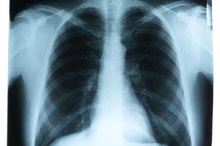12 Killer Superbugs That Could Cause the World's Next Plague
There’s nothing more inconvenient than the sudden onset of a sore throat and runny nose. But it’s not like you have to worry about dying or spreading a plague to all of mankind, right? Wrong. According to new report released by the World Health Organization, the phrase “biological threat” isn’t reserved for sci-fi movies anymore. Certain families of bacteria have become resistant to multiple antimicrobial medicines (including antibiotics), meaning that we no longer have the power to prevent them from killing people. Yikes! To promote the research and development of new antibiotics, the WHO released a “dirty dozen” list of the families of bacteria that pose the greatest threat to human health and ranked them in terms of medium, high or critical priority. Find out which bacteria are the most dangerous and how to avoid becoming infected.
If you are experiencing serious medical symptoms, seek emergency treatment immediately.
12. Shigella spp., fluoroquinolone-resistant
Those maladies that find themselves on the medium-priority list are becoming increasingly drug-resistant and common diseases, such as shigellosis, an infection brought on by the Shigella group of bacteria. While some people who contract shigellosis show no symptoms, most experience diarrhea, fever and stomach cramps, according to the Centers for Disease Control and Prevention. Shigellosis is spread through contact with the stool of an infected person, which actually happens way more often than is comfortable to admit, as tiny particles of poop can lurk on hands and surfaces. Moral of the story? Wash your hands frequently. Risk: Medium
11. Haemophilus influenzae, ampicillin-resistant
Best Probiotics For Managing a C-Diff Infection
Learn More
You might be wondering why people are suddenly freaking out about antibiotic resistance. We’ve depended on antibiotics to quickly and easily do away with infections since the 1940s, and since that time scientists have developed more than 100 antibiotic compounds, according to the Los Angeles Times. However, bacteria have been slowly developing a resistance to these drugs — a process that’s been expedited by the routine use of antibiotics on livestock and misuse in humans. All of this results in antibiotic-resistant bacteria like Haemophilus influenzae, a type of bacteria that, according to the CDC, primarily causes illness in infants. Risk: Medium
Listen now: Why America’s Obsession with ‘Happiness’ Is Totally Stressing Us Out
10. Streptococcus pneumoniae, penicillin-nonsusceptible (Medium)
You can probably guess from its name what illnesses Streptococcus pneumoniae bacteria can cause. According to the CDC, those infected with pneumococcal disease can develop “pneumonia (infection of the lungs), ear infections, sinus infections, meningitis (infection of the covering around the brain and spinal cord) and bacteremia (blood stream infection).” If all that doesn’t sound serious enough, know that an estimated 900,000 Americans get pneumococcal pneumonia every year, and about 5 to 7 percent die. That’s 45,000 to 63,000 Americans who die every year from a disease that’s getting even deadlier due to drug resistance. Risk: Medium
Read more: The 21 Most Lethal Places in America
9. Neisseria gonorrhoeae, cephalosporin- & fluoroquinolone-resistant (High)
What Is the Difference Between a Yeast Infection & Fungus?
Learn More
We all went to sex-ed. And we all know that gonorrhea, though it sounds nasty, is one of the curable (and therefore harmless) sexually transmitted infections. But that is where we are all so very wrong. The emergence of multidrug- and cephalosporin-resistant gonorrhea in the U.S. makes it incredibly difficult to treat. CNBC reports that of the 820,000 cases of gonorrhea that are reported in the U.S. every year, 246,000 of those cases involve a drug-resistant strain. If left untreated (or, say, if it’s impossible to treat because it becomes resistant to the available antibiotics) gonorrhea can cause pelvic inflammatory disease, which can lead to infertility or even death. So you can add gonorrhea to your list of reasons why you need to use a condom during sex to quite literally avoid death. Risk: Medium
Read more: 10 of the Most Deadly States for Cancer
8. Salmonellae, fluoroquinolone-resistant (High)
We’ve made it to the WHO’s next priority level. First on our the high-priority list is something you might have heard of if you were dared to eat a raw egg as a child. Salmonellae bacteria causes salmonella, a foodborne illness that can be found in eggs, undercooked poultry, ground meat, fruit, peanuts and more. Commonly referred to as “food poisoning,” many cases of salmonella pass untreated, according to the CDC. However, of the estimated 1 million illnesses it causes in the U.S. every year, 19,000 result in hospitalizations and 380 result in death. Risk: Medium
7. Campylobacter spp., fluoroquinolone-resistant (High)
Campylobacter spp. causes a foodborne illness called campylobacteriosis, which, like salmonella, sounds pretty nasty. According to the CDC, people with campylobacteriosis experience diarrhea, cramping, abdominal pain and fever. And we would be remiss not to mention that said diarrhea might be bloody and (like this description) “accompanied by nausea and vomiting.” How do you avoid all of this? Well, it’s primarily transmitted via undercooked meat and meat products and raw or contaminated milk, so make sure that your meat is fully cooked and strongly consider avoiding raw milk. Risk: Medium
Read more: The 10 Cities With the Highest HIV Rates
6. Helicobacter pylori, clarithromycin-resistant
You’ve probably never heard of Helicobacter pylori before, but chances are it’s already living inside of you. Believe it. According to MedlinePlus, two-thirds of the world’s population have these bacteria, which causes infections in the stomach that can lead to peptic ulcers and stomach cancer. About 10,960 Americans will die this year from stomach cancer, according to the American Cancer Society, and The New York Times reports that around 6,500 people die every year from peptic ulcers. While antibiotics can’t treat stomach cancer, they are very successful when it comes to treating peptic ulcers — for now. Risk: High
5. Staphylococcus aureus, methicillin-resistant, vancomycin-intermediate
Anyone who’s spent a lot of time in locker rooms might be familiar with these bacteria. In fact, Staphylococcus aureus doesn’t just hang out on damp, artificial lawns — it’s actually found in about 25 percent of healthy people, according to Foodsafety.gov. It causes most staph infections, according to MedlinePlus, including skin infections, pneumonia, food poisoning and more. The drug-resistant staph infections are already such a major concern in America that we even have a household name for them: methicillin-resistant Staphylococcus aureus, or MRSA. According to the CDC, there are about 11,285 MRSA-related deaths every year in the U.S. To avoid infection, wash your hands often, clean and cover open wounds and avoid sharing items used for personal hygiene. Risk: High
Read more: The 15 Most Deadly Countries for Air Pollution
4. Enterococcus faecium, vancomycin-resistant
Enterocucci bacteria are “normally present in human intestines and in the female genital tract and are often found in the environment,” the CDC writes. While vancomycin-resistant Enterococcus faecium (VRE) often live there without incident like the best neighbors, they can sometimes cause infections in the urinary tract, bloodstream and wounds associated with catheters and surgical procedures. That last bit means that most VRE infections happen in hospitals. VRE isn’t airborne, but spread through contact with caregiver’s hands or with contaminated surfaces. So if you’re a patient, keep your hands clean always. Risk: High
3. Enterobacteriaceae, carbapenem-resistant, ESBL-producing
Here we enter the WHO’s list of the worst of the worst. The superbugs listed as critical “pose a particular threat in hospitals, nursing homes and among patients whose care requires devices, such as ventilators and blood catheters,” the WHO writes. “They can cause severe and often deadly infections, such as bloodstream infections and pneumonia.” They’re resistant to most antibiotics, including carbapenems and third-generation cephalorsporins — the best antibiotics out there for treating resistant bacteria. So what makes carbapenem-resistant Enterobacteriaceae (CRE) so threatening? Although they typically only affect people in health care settings, the CDC reports that “they can contribute to death in up to 50 percent of patients who become infected.” Risk: Critical
2. Pseudomonas aeruginosa, carbapenem-resistant
Again, Pseudomonas aeruginosa primarily affects people in hospital settings who rely on devices like breathing machines and catheters and those who have wounds from surgery or burns. About 51,000 P. aeruginosa-related infections occur in the U.S. every year, and more than 13 percent, or 6,000 of those infections, are multidrug-resistant, leading to around 400 deaths. Risk: Critical
Read more: 12 Not-So-Common Treatments for Cold and Flu
1. Acinetobacter baumannii, carbapenem-resistant
Acinetobacter baumannii loves to kick people when they’re down, causing infections mainly in intensive care units and other health care settings. Like the other multidrug-resistant infections on the WHO’s critical list, Acinetobacter infections place already-ill patients at a higher risk of mortality. These bacteria can survive on a surface for days, so patients should make a habit of frequently washing their hands and sanitizing surfaces. Risk: Critical
What Do YOU Think?
Have you caught any of these infections before? Which of these sounds most terrifying to you? What are ways that you can help to reduce our use of antibiotics? Tell us in the comments section!
Read more: 20 Foods That Will Make Your Cold Worse
Related Articles
- NPR: WHO’s First-Ever List Of The Dirty Dozen Superbugs
- World Health Organization: Media Centre: WHO Publishes list of bacteria for which new antibiotics are urgently needed
- World Health Organization: Media Centre: Antibiotic Resistance
- World Health Organization: Media centre: Antimicrobial resistance
- Centers for Disease Control and Prevention: Shigella – Shigellosis
- Centers for Disease Control and Prevention: Shigella – Shigellosis General Information, Frequently Asked Questions
- Centers for Disease Control and Prevention: Haemophilus influenza Disease (Including HiB)
- Centers for Disease Control and Prevention: Traveler’s Health: Pneumococcal Disease (Streptococcus pneumoniae)
- Centers for Disease Control and Prevention: Pneumococcal Disease Fast Facts
- Centers for Disease Control and Prevention: 2014 Sexually Transmitted Diseases Surveillance: Gonorrhea
- Centers for Disease Control and Prevention: Antibiotic-Resistant Gonorrhea
- CNBC: Gonorrhea strain makes CDC issue ‘urgent threat’
- The Naked Truth: Gonorrhea
- Centers for Disease Control and Prevention: Salmonella
- Centers for Disease Control and Prevention: CDC Features: Salmonella is a Sneaky Germ: Seven Tips for Safer Eating
- World Health Organization: Media Center: Campylobacter
- Centers for Disease Control and Prevention: Food Safety: Campylobacter
- The New Yorker: Germs Are Us
- MedlinePlus: Helicobacter Pylori Infections
- The New York Times: Health Guide: Peptic Ulcer
- estradaanton/Adobe Stock









